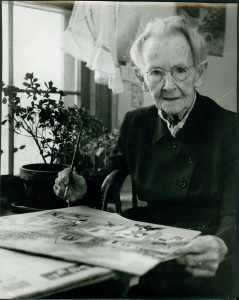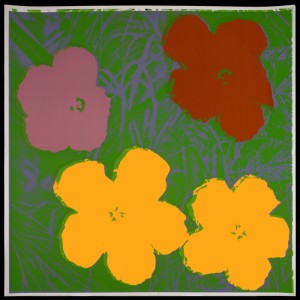
Anna Mary Robertson “Grandma” Moses (1860-1961), “Catchin’ The Turkey,” 1955. Oil on pressed wood, 12 x 16 inches. COLLECTION OF BENNINGTON MUSEUM (C) 2017, GRANDMA MOSES PROPERTIES CO. NEW YORK

Anna Mary Robertson “Grandma” Moses, 1958. Silver gelatin print, 8 x 10 inches. COLLECTION OF BENNINGTON MUSEUM
Would you ever associate Grandma Moses with Modernism? The same people who embraced Modernism in America in the 1930s and ’40s were also collecting folk art. It was at this time that curators and collectors began to make connections between what they called the “American Primitives” and the most advanced contemporary art. In fact, the first public exhibition of Grandma Moses’s paintings was held at the Museum of Modern Art in 1939, and was organized by Sidney Janis, who later became famous as the gallerist who represented Abstract Expressionism and Pop Art.
Bennington Museum is home to the largest public collection of paintings by Anna Mary Robertson Moses (1860-1961). Better known as Grandma Moses, the artist was catapulted to international fame during the ’40s as the result of her charming, naïvely executed paintings of rural American farm life. But she was so much more than a homespun folk hero. The popular view is that she simply painted scenes remembered from her childhood. In fact, she was a highly skilled artist who refined her art through practice and created a unique world of her own imagining. She combined multiple perspectives in the same painting and used collage and popular imagery, unconsciously paralleling the techniques of Cubism, Surrealism, and Pop Art.

Andy Warhol (1928-1987), “Flowers,” 1970. Color screenprint on paper, 38 x 38 inches. Williams College Museum of Art, Williamstown, Mass. Gift of the Andy Warhol Foundation for the Visual Arts (M.2014.1.2) © 2017 The Andy Warhol Foundation for the Visual Arts, Inc. / Artists Rights Society (ARS), New York
Grandma Moses: American Modern, on view at the Bennington Museum, its final venue, July 1 through November 5, has a subversive goal, for it will upset your expectations and get you to look at this beloved American artist with fresh eyes. It is a long-overdue exhibition that will reestablish her place in the mid-century art world that was embracing modern art at the same time. By putting her paintings side by side with works by such iconic Modernists as Fernand Léger, Joseph Cornell, Helen Frankenthaler, and Andy Warhol, and folk artists such as Edward Hicks and Joseph Pickett, the exhibition will allow visitors to discover for themselves how all these artists drew on found images, color, collage, memory, and their own innate artistic sensibility to create original masterpieces.
Like any trained artist, Moses used thought, planning, and intuition to create works of enormous vitality and imagination.
The exhibition is organized by Shelburne Museum and Bennington Museum, and combines their two great collections of the painter’s work, supplemented with key loans from private collections arranged by Galerie St. Etienne of New York City. Bennington Museum augments this exhibition with over 20 additional masterpieces on loan from public and private collections on view in the museum’s permanent Grandma Moses Gallery. The result: an almost unprecedented opportunity to see more than 60 works by this colorful American painter throughout three galleries, the largest group of works by Moses assembled in decades.
Bennington Museum is a member of ArtCountry, a consortium of notable art and performance destinations in the scenic northern Berkshires of Massachusetts and Southern Vermont, including the Clark Art Institute, Williams College Museum of Art, Williamstown Theatre Festival, and MASS MoCA. For more information on these five great cultural centers, visit http://www.ArtCountry.org.





















































